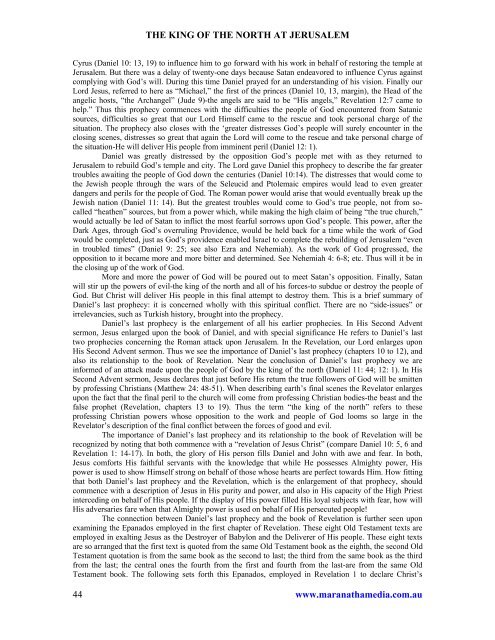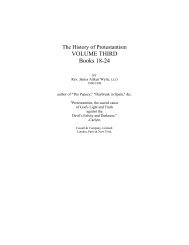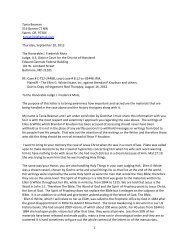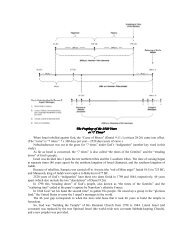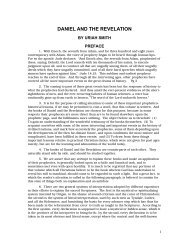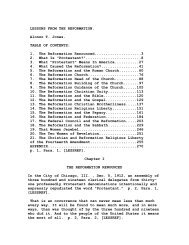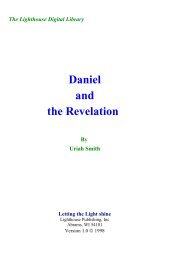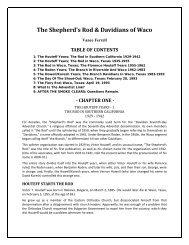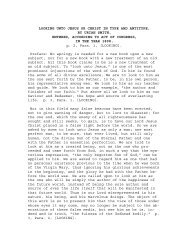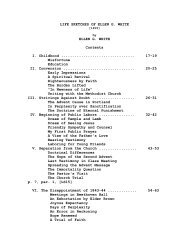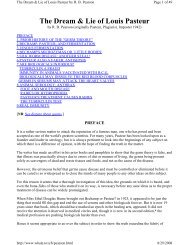Kings Of The North - Amazing Discoveries
Kings Of The North - Amazing Discoveries
Kings Of The North - Amazing Discoveries
You also want an ePaper? Increase the reach of your titles
YUMPU automatically turns print PDFs into web optimized ePapers that Google loves.
THE KING OF THE NORTH AT JERUSALEM<br />
Cyrus (Daniel 10: 13, 19) to influence him to go forward with his work in behalf of restoring the temple at<br />
Jerusalem. But there was a delay of twenty-one days because Satan endeavored to influence Cyrus against<br />
complying with God’s will. During this time Daniel prayed for an understanding of his vision. Finally our<br />
Lord Jesus, referred to here as “Michael,” the first of the princes (Daniel 10, 13, margin), the Head of the<br />
angelic hosts, “the Archangel” (Jude 9)-the angels are said to be “His angels,” Revelation 12:7 came to<br />
help.” Thus this prophecy commences with the difficulties the people of God encountered from Satanic<br />
sources, difficulties so great that our Lord Himself came to the rescue and took personal charge of the<br />
situation. <strong>The</strong> prophecy also closes with the ‘greater distresses God’s people will surely encounter in the<br />
closing scenes, distresses so great that again the Lord will come to the rescue and take personal charge of<br />
the situation-He will deliver His people from imminent peril (Daniel 12: 1).<br />
Daniel was greatly distressed by the opposition God’s people met with as they returned to<br />
Jerusalem to rebuild God’s temple and city. <strong>The</strong> Lord gave Daniel this prophecy to describe the far greater<br />
troubles awaiting the people of God down the centuries (Daniel 10:14). <strong>The</strong> distresses that would come to<br />
the Jewish people through the wars of the Seleucid and Ptolemaic empires would lead to even greater<br />
dangers and perils for the people of God. <strong>The</strong> Roman power would arise that would eventually break up the<br />
Jewish nation (Daniel 11: 14). But the greatest troubles would come to God’s true people, not from socalled<br />
“heathen” sources, but from a power which, while making the high claim of being “the true church,”<br />
would actually be led of Satan to inflict the most fearful sorrows upon God’s people. This power, after the<br />
Dark Ages, through God’s overruling Providence, would be held back for a time while the work of God<br />
would be completed, just as God’s providence enabled Israel to complete the rebuilding of Jerusalem “even<br />
in troubled times” (Daniel 9: 25; see also Ezra and Nehemiah). As the work of God progressed, the<br />
opposition to it became more and more bitter and determined. See Nehemiah 4: 6-8; etc. Thus will it be in<br />
the closing up of the work of God.<br />
More and more the power of God will be poured out to meet Satan’s opposition. Finally, Satan<br />
will stir up the powers of evil-the king of the north and all of his forces-to subdue or destroy the people of<br />
God. But Christ will deliver His people in this final attempt to destroy them. This is a brief summary of<br />
Daniel’s last prophecy: it is concerned wholly with this spiritual conflict. <strong>The</strong>re are no “side-issues” or<br />
irrelevancies, such as Turkish history, brought into the prophecy.<br />
Daniel’s last prophecy is the enlargement of all his earlier prophecies. In His Second Advent<br />
sermon, Jesus enlarged upon the book of Daniel, and with special significance He refers to Daniel’s last<br />
two prophecies concerning the Roman attack upon Jerusalem. In the Revelation, our Lord enlarges upon<br />
His Second Advent sermon. Thus we see the importance of Daniel’s last prophecy (chapters 10 to 12), and<br />
also its relationship to the book of Revelation. Near the conclusion of Daniel’s last prophecy we are<br />
informed of an attack made upon the people of God by the king of the north (Daniel 11: 44; 12: 1). In His<br />
Second Advent sermon, Jesus declares that just before His return the true followers of God will be smitten<br />
by professing Christians (Matthew 24: 48-51). When describing earth’s final scenes the Revelator enlarges<br />
upon the fact that the final peril to the church will come from professing Christian bodies-the beast and the<br />
false prophet (Revelation, chapters 13 to 19). Thus the term “the king of the north” refers to these<br />
professing Christian powers whose opposition to the work and people of God looms so large in the<br />
Revelator’s description of the final conflict between the forces of good and evil.<br />
<strong>The</strong> importance of Daniel’s last prophecy and its relationship to the book of Revelation will be<br />
recognized by noting that both commence with a “revelation of Jesus Christ” (compare Daniel 10: 5, 6 and<br />
Revelation 1: 14-17). In both, the glory of His person fills Daniel and John with awe and fear. In both,<br />
Jesus comforts His faithful servants with the knowledge that while He possesses Almighty power, His<br />
power is used to show Himself strong on behalf of those whose hearts are perfect towards Him. How fitting<br />
that both Daniel’s last prophecy and the Revelation, which is the enlargement of that prophecy, should<br />
commence with a description of Jesus in His purity and power, and also in His capacity of the High Priest<br />
interceding on behalf of His people. If the display of His power filled His loyal subjects with fear, how will<br />
His adversaries fare when that Almighty power is used on behalf of His persecuted people!<br />
<strong>The</strong> connection between Daniel’s last prophecy and the book of Revelation is further seen upon<br />
examining the Epanados employed in the first chapter of Revelation. <strong>The</strong>se eight Old Testament texts are<br />
employed in exalting Jesus as the Destroyer of Babylon and the Deliverer of His people. <strong>The</strong>se eight texts<br />
are so arranged that the first text is quoted from the same Old Testament book as the eighth, the second Old<br />
Testament quotation is from the same book as the second to last; the third from the same book as the third<br />
from the last; the central ones the fourth from the first and fourth from the last-are from the same Old<br />
Testament book. <strong>The</strong> following sets forth this Epanados, employed in Revelation 1 to declare Christ’s<br />
44<br />
www.maranathamedia.com.au


